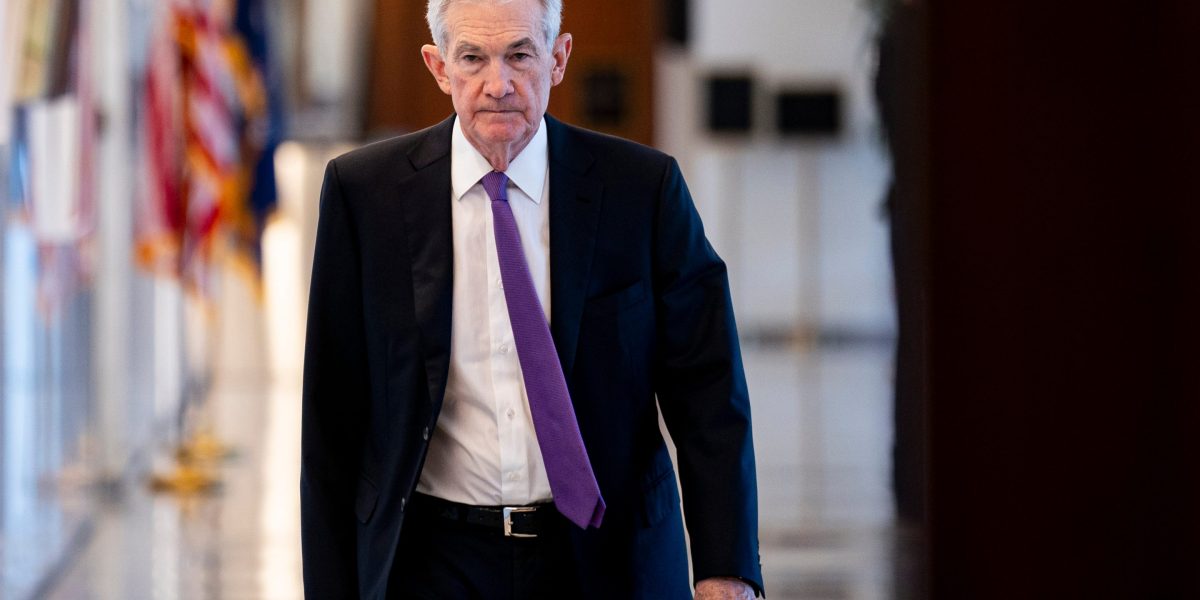

US inflation probably picked up modestly in July, but not enough to derail the Federal Reserve from a widely anticipated interest-rate cut next month.
The consumer price index on Wednesday is expected to have risen 0.2% from June for both the headline figure and the so-called core gauge that excludes food and energy. While each would be an acceleration from June, the annual metrics should continue to rise at some of the slowest paces seen since early 2021.
The recent easing of price pressures has bolstered Fed officials’ confidence that they can start to lower borrowing costs while refocusing their attention on the labor market, which is showing greater signs of slowing.
The July jobs report showed US employers substantially scaled back hiring and the unemployment rate rose for a fourth month, triggering a key recession indicator and contributing to a global stock market selloff.
Should the CPI come in as expected, it would indicate that inflation remains on a downward trend, and economists reckon a slight pickup is due after June’s surprisingly low reading. They see the reversal largely stemming from what’s known as core services excluding housing — a key category watched by policymakers. Some forecasters are also flagging an upside risk to goods prices given higher shipping costs.
However, the long-awaited slowdown in shelter costs that started in June should continue. That category comprises about a third of the overall CPI and is a big determinant of the broader inflation trend.
The producer price index — due a day before the CPI — will be scrutinized for categories that feed through to the Fed’s preferred inflation gauge, the personal consumption expenditures price index.
Another report in the coming week is expected to show a pickup in overall retail sales in July, but once certain components are stripped out to drill down to the control group — which is used to calculate gross domestic product — sales should slow notably.
Other data on the agenda include the latest readings on inflation expectations, small business sentiment, industrial production and new home construction. Regional Fed presidents Raphael Bostic, Alberto Musalem, Patrick Harker and Austan Goolsbee are scheduled to speak.
Looking north, housing starts for July will reveal whether the Bank of Canada’s back-to-back rate cuts are helping to stoke investment in new building. Canadian wholesale and manufacturing sales for June are expected to decline.
Elsewhere, key data in the UK from wages to inflation, production and retail numbers from China, and likely decisions to keep rates unchanged in Norway and New Zealand are among the highlights.
Asia
China’s data blast on Thursday will likely show the economy did a little better in July versus June but is still mostly limping along.
Industrial output growth may have accelerated to 5.5%, a pace that’s still slow enough to drag the year-to-date tally down a tad.
The same goes for retail sales, which are seen picking up to 2.6% while pulling the seven-month pace down to 3.5%. Fixed asset investment is seen holding steady, while the decline in property investment is forecast to moderate.
The nation’s credit growth likely slowed in July, despite a cut in the key rate from the People’s Bank of China and a reduction in loan prime rates.
Elsewhere, Japan’s second-quarter GDP is expected to have rebounded to a 2.3% expansion on an annualized basis, and Taiwan and Kazakhstan also get second-quarter GDP figures.
Australia will publish wage price figures, consumer confidence and the NAB business confidence survey, all on Tuesday.
India’s consumer inflation is forecast to slow below 4% in July, while its industrial output growth may have decelerated in June. Trade statistics are due from India and Indonesia.
Among central banks, the Reserve Bank of New Zealand is expected to hold its official cash rate at 5.5% when it meets on Wednesday, although a cut hasn’t been ruled out. Central bankers in the Philippines gather a day later.
Europe, Middle East, Africa
The UK will take center stage, with four days of releases informing the Bank of England on the economy in the same month it delivered an initial rate cut and signaled there’s more to come.
Data on Tuesday that’s likely to show slowing wage growth may be among the most significant, though inflation the following day will also be watched for evidence of lingering pressures — in particular the services measure that may come in with price growth still stuck above 5%.
Monthly GDP on Thursday is predicted to reveal hardly any growth in June, though second-quarter output due the same day could show 0.6% expansion. On Friday, retail sales will probably show an increase for July after a drop the previous month.
The Nordics are also likely to draw focus, most significantly Norway. Norges Bank on Thursday is expected to keep its rate at 4.5%, consistent with a more aggressive stance taken in June, when officials effectively postponed monetary easing until 2025.
Core inflation has slowed faster this year than officials forecast, but the energy-rich economy has also coped better than expected with the highest credit costs since 2008; wage pressures remain high and the labor market has softened only marginally.
Against that backdrop, investors will look for any signs of concern about the krone, the worst performer in the Group of 10 currencies so far this year.
In Sweden, data on Wednesday will show whether underlying inflation in the largest Nordic economy continued to slow in July. That will provide key evidence for policymakers who are widely expected to proceed with monetary easing this month after previously signaling as many as three rate cuts in the second half of the year.
Inflation numbers will also be released in Denmark and the Czech Republic on Monday, while second quarter GDP numbers are due in Poland on Wednesday and Switzerland on Thursday.
The euro zone will have a relatively quiet week. Germany’s ZEW investor confidence index on Tuesday, along with euro-zone industrial production and Dutch GDP on Wednesday, are among the main items due. European Central Bank officials are largely on holiday, and much of southern Europe will be off on Thursday.
Turning south, Zambia on Wednesday is poised to raise rates for a seventh straight time to curb double-digit inflation and support the kwacha.
The same day, Namibia is set to keep its rate at 7.75% in line with South Africa’s unchanged stance last month. The Namibian dollar is pegged to the rand, which means monetary policy is often guided by the South African Reserve Bank’s actions.
Nigerian data on Thursday will likely show inflation eased for the first time in 19 months, helped by favorable annual comparisons along with measures to reduce the cost of food, including a 180-day window to import wheat and corn duty free.
Also on Thursday, Israel’s inflation probably quickened to 3.1% in July, forecasts show, as the war in Gaza strains the economy and government spending soars. That outcome would exceed the target range of 1% to 3% for the first time since November.
Latin America
Argentina is due to report July inflation data, and economists surveyed by the central bank see the monthly figure slowing to 3.9% from 25.5% as recently as December. Annual inflation may slow for a third month, to roughly 263%.
Also from Argentina, the Economy Ministry will report its July budget balance, currently riding a six-month streak of surpluses.
The central banks of Brazil, Colombia and Chile post surveys of economist expectations in the coming week. Chile also publishes a separate poll of traders, who correctly called Banco Central de Chile’s July 31 rate pause.
Uruguay’s new central bank chief Washington Ribeiro and his colleagues may keep their key rate at 8.5% after July inflation drifted slightly higher, to 5.45%. Inflation has been within the bank’s 3% to 6% target range for the past 14 months.
Brazil, Peru and Colombia will report June GDP-proxy data, with Colombia also posting April-June output figures.
All three economies expanded faster than expected in April and May, providing positive growth carryover for the full second quarter.
Since slumping in mid-2023, Colombia’s economy has subsequently posted quarter-on-quarter prints of 1% and 1.1%. Year-on-year forecasts range from 2.8% to 3.3%.















